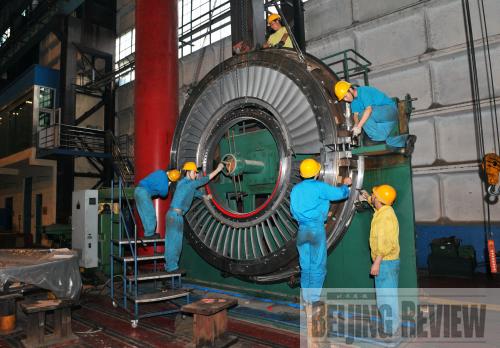|
 |
|
WINDING UP: Workers operate machinery at Dongfang Steam Turbine Works in Deyang, Sichuan Province. China's overall industrial production increased steadily in the first quarter |
China's economy regains momentum thanks to the government's stimulus measures
"It's really hard-earned for the Chinese economy to get stable and warm again," said Li Xiaochao, spokesman of the National Bureau of Statistics (NBS), at a press conference held in Beijing on April 16. "It's the result of massive stimulus policies timely launched by the Chinese Government."
Since last November, the government has adopted a stimulus package to counter the effects of a marked decrease in international demand for the country's goods and the growing pressure on domestic economic growth brought about by the global financial crisis. This package includes a 4-trillion-yuan ($586 billion) investment and 10 industrial stimulus plans.
Li presented a detailed analysis about the stimulus package and noted that it includes not only policies to increase investment and consumption and expand domestic demand, but also policies to stabilize exports such as increased tax rebate rates. It contains proactive fiscal policies such as increasing the number of treasury bond issues and structural tax cuts. It also calls for appropriately accommodative monetary policies such as a reduced interest rates and deposit reserve ratios. Various government departments and local governments at all levels are working hard to implement these policies in accordance with the requirements and arrangements of the Central Government, thereby contributing to the country's economic recovery.
Positive changes
The overall national economy has shown some positive changes thanks to the stimulus package, Li said.
Industrial production has increased steadily. In March, the added value completed by enterprises with annual sales revenue of more than 5 million yuan ($732,064) increased 8.3 percent year on year, and was 4.5 percentage points higher than the rate in the January-February period.
"In regard to industry, the most difficult time was between last November and this February," Li said. "Industrial growth has recovered to the level in last October (8.2 percent)."
Among the country's current 39 industrial sectors, 33 are growing, accounting for 80 percent of all sectors, Li said. He noted that while the textile and garment industry had been losing money, its profit rose 15.6 percent in the first quarter. The petroleum processing and coking industry recovered from 19.4-billion-yuan ($2.84 billion) in losses in the same period last year to make 11.7-billion-yuan ($1.71 billion) in profit in the first quarter of this year, Li said.
Signs of an economic turnaround can be seen elsewhere in the first-quarter figures. Agricultural development remained stable with the sowing area of grain rising for the last six consecutive years. Meat output rose 6 percent year on year.
Li noted that China's fixed-asset investment increased quickly in the first quarter and was up 28.8 percent over a year ago. Retail sales of consumer goods also rose fast. In the first quarter, they were up 15.9 percent, which was 3.6 percentage points higher than the same period last year, and 1.1 percentage points higher than in 2008. In the meantime, consumption in rural areas grew faster than in cities.
"Faster growth in investment and consumption shows that the government's policies of expanding investment and promoting consumption have achieved great effects," Li said.
Increased lending by financial institutions also has supported the country's economic recovery. In the first quarter, the amount of loans issued by financial institutions hit a record high. The outstanding amount of loans among all financial institutions totaled 34.96 trillion yuan ($5.12 trillion), an increase of 4.58 trillion yuan ($670.57 billion) over the beginning of the year.
"We don't need to worry about a shortage of liquid capital," Li said.
Key business indexes also pointed to economic buoyancy. At present, social confidence is rising and the purchasing manager index has been up for the fourth consecutive month, Li said.
"More happily, both the entrepreneur confidence index and the business climate index were in an upswing in the first quarter," he said.
The effects of the stimulus package helped narrow the decline in China's exports. In March, exports dropped 17.1 percent over a year ago, which was 4 percentage points less than the decrease in the January-February period. The decline in fiscal revenue also narrowed. In March, national fiscal revenue dropped 0.3 percent year on year, which was 11.1 percentage points lower than the decrease in the first two months.
Domestic demand to the rescue
Economic figures in the first quarter indicate that international demand for Chinese products did not play an active role. Instead, it encumbered GDP growth, while domestic demand became the major force lifting the economy.
Yao Jingyuan, NBS Chief Economist, told Beijing Reviewthat investment and consumption contributed 4.3 percentage points and 2 percentage points, respectively, to the 6.1-percent GDP growth in the first quarter, while foreign trade imposed a negative 0.2 percentage points to GDP growth.
| 